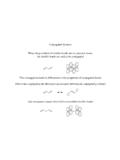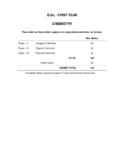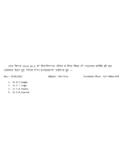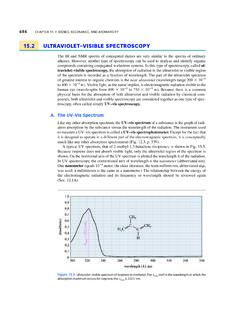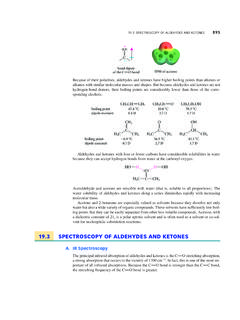Transcription of Organic Chemistry Lecture Outline Chapter 14: …
1 Organic Chemistry Lecture Outline Chapter 14: Conjugated Dienes /UV Spectroscopy I. TYPES OF DIENES; CONJUGATED, UNCONJUGATED AND CUMULATED. A. CONJUGATED DIENES, TRIENES, TETRAENES, 1. A conjugated diene contains two double bonds that alternate with a single bond. A conjugated triene contains three alternating double bonds. A conjugated tetraene contains four alternating double bonds, 2. Conjugated systems are more stable than unconjugated systems. 3. Pi electrons can be delocalized through conjugated systems.
2 B. UNCONJUGATED DIENES OR "ISOLATED" DIENES 1. An unconjugated diene has the two double bonds of the molecule separated by more than one single bond. 2. Pi electrons cannot be delocalized in unconjugated systems. C. CUMULATED DIENES OR "ALLENES" 1. A cumulated diene has a single carbon atom common to the two double bonds of the molecule. 2. Allenes have a unique geometry due to the fact that the common carbon atom is sp hybridized. D. OTHER CONJUGATED SYSTEMS 1. Trienes, tetraenes, can also be conjugated.
3 Generally, the longer the conjugation, the more stable the molecule. 2. An "enone" has a C=O in conjugation with an alkene. 3. Triple bonds can also be in conjugation with other pi systems. II. ALLYLIC GROUPS The allyl group is a three carbon unit containing a double bond and a single bond, , propene. Allylic carbon atoms ( , the carbon atom one removed from the double bond) form very stable reaction intermediates due to resonance. A. ALLYLIC CARBOCATIONS 1. Allylic carbocations are formed in EA reactions of conjugated dienes or SN1 reactions of molecules with leaving groups bonded to an allylic carbon atom.
4 2. Allylic carbocations are more stable than alkyl carbocations. 3. Mixtures of products result in these reactions due to resonance forms of the allylic carbocation intermediate. B. ALLYLIC RADIALS 1. Allylic radical intermediates form in halogenation reactions with Cl2 or with NBS. 2. Mixtures of products result in these reactions due to resonance forms of the allylic radical intermediate. C. ALLYLIC CARBANIONS 1. Allylic hydrogens are somewhat acidic (pKa~35) and can be deprotonated to form allylic carbanions.
5 2. Allylic carbanions are more stable than alkyl carbanions. III. REACTIONS OF CONJUGATED DIENES A. ELECTROPHILIC ADDITION (H-X, X2) 1. Electrophilic addition of conjugated dienes occurs through exactly the same mechanism as electrophilic addition of alkenes. 2. Mixtures of positional isomers (1,2- and 1,4-products) occurs with conjugated dienes. 3. The ratios of the mixtures of isomers that are obtained in these electrophilic addition reactions can be explained by considering the THERMODYNAMIC and KINETIC CONTROL of reactions.
6 B. Two possible stoichiometric conditions may exist for the reaction of conjugated dienes with an electrophile. 1. Excess of electrophilic reagent If excess E+ is available, both alkenes of the diene will react 2. One molar equivalent of electrophilic reagent. If one molar equivalent of E+ is available, only one of the alkenes will react. Organic Chemistry Lecture Outline Chapter 14: Conjugated Dienes /UV Spectroscopy C. THERMODYNAMIC CONDITIONS Thermodynamic conditions are high temperature conditions (rt or above) which favor the formation of the most stable product, regardless of the stability of the reaction intermediate.
7 Under thermodynamic conditions, all possible reaction intermediates and their resonance forms must be considered when attempting to predict a thermodynamic product(s). D. KINETIC CONDITIONS Kinetic conditions are low temperature conditions (0 C or lower) which favor formation of the product derived from the most stable reaction intermediate regardless of the stability of the final product. All reaction intermediates and resonance forms of reaction intermediates must be considered when attempting to predict the kinetic product(s) of the reaction.
8 Both the stoichiometric and overall reaction (thermodynamic or kinetic) reaction conditions must be considered when predicting reaction products from electrophilic addition of conjugated dienes. IV. DIELS-ALDER CYCLOADDITION REACTIONS Diels Alder Reactions are referred to as 4 +2 cycloadditions, based on the number of pi bonds associated with each of the two pi systems undergoing reaction. Six-membered ring formation occurs as a result of two distinct pi systems adding to either pi systems of two different molecules (intermolecular) or within same molecule (intramolecular).
9 Intermolecular Intramolecular SS A. The Diels Alder reaction occurs between a diene and an alkene or alkyne (referred to as the dienophile). The resulting product is a 6-membered ring. +dienedienophile B. The diene must adopt the s-cis conformation to react in the Diels Alder reaction. s-transs-cis Organic Chemistry Lecture Outline Chapter 14: Conjugated Dienes /UV Spectroscopy C. Electron-withdrawing groups (EWG) and electron donating groups (EDG) on the diene and dienophile influence the regiochemistry of the reaction.
10 +dienedienophileNOO OCH3 +dienedienophile NO2 OCH3 OCH3NO2 OCH3notNO2NO2 OCH3NO2notOCH3 D. The Diels Alder reaction is stereospecific with respect to the E/Z stereochemistry of the dieneophile and the diene . OCH3OH3CO+OCH3+OOCH3 OCH3 OOCH3 OCH3 OOCH3 E. For dienophiles, there are two stereochemical orientations for addition, with respect to the diene , referred to as endo and exo. Consider the reaction of cyclopentadiene with the dienophile, maleic anhydride. In general, endo products are favored. OOOcyclopentadienemaleic anhydride+OHHOOOOO+endoexo Organic Chemistry Lecture Outline Chapter 14: Conjugated Dienes /UV Spectroscopy V.

